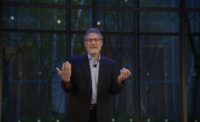Of all President Trump’s campaign promises, the proposal to invest $1 trillion in infrastructure was one of the few to appeal to Republicans and Democrats alike. That level of spending would have dramatically reversed decades of dwindling public investment in the country’s roads, transit, and utilities. Now that scale of investment is less likely than ever, given the reality of the cuts the President called for in the budget he sent to Congress, and the wrangling over spending that will unfold on Capitol Hill. But all the attention on major infrastructure needs clouded other concerns about the built environment.
More than bridges and airports need updating. The assumption that infrastructure only means pouring concrete and laying fiber is outdated. In the past, infrastructure sought to connect people across great distances and provide basic amenities for everyone. Today, proximity and access are not enough to cross the chasms of race, economic class, and new social boundaries like media bubbles and deeply partisan politics.
The need for “soft” or civic infrastructure in our cities and communities has never been greater. It comes at a time when declining social capital has left much of America divided, suspicious, and aloof. Today, one-third of people report having no interactions with their neighbors, and average Americans spend up to five hours a day watching television. The share of the population that says, “Most people can be trusted” has fallen from a majority in the 1970s to about one-third. And income inequality and wage stagnation have decimated the middle class, further dividing society into haves and have-nots.
Cities, meanwhile, have been taking the lead to address these social disparities by vastly improving the public realm, though not all new civic spaces have been successful in doing so. The High Line in New York, built mostly with city funds but maintained by a private nonprofit, attracts almost 5 million tourists and visitors a year, but its outsize popularity has driven up real-estate prices and sparked so much gentrification that many residents of nearby public housing projects feel as if the 1½-mile elevated promenade is not for them. Millennium Park in Chicago provides a great open space for all, but was financed in part through real-estate taxes from a growing periphery of luxury developments. These civic spaces and others like them send mixed messages: Are they high design for everyone, or are they really trickle-down urbanism, where an amenity for the donor class happens to have some benefits for the other 99 percent?
A raft of projects across the country demonstrate how the public and private sectors, along with the design community, are taking new approaches to addressing economic and social segregation, often by reclaiming underused, existing civic spaces. Parks, rec centers, and libraries, among other familiar typologies, have long played an important role in providing a sense of social connectedness, but up until recently, they have been stuck in a vicious cycle of lack of investment and fluctuating public interest. “We own this very rich collection of civic assets, but they have been increasingly abandoned by people who could afford to pay for private alternatives,” says Carol Coletta, senior fellow at the Kresge Foundation. She cites people who are able to buy on Amazon rather than go to the library, or use a private gym instead of a rec center. “All of those things have conspired to pull the middle class and upper-middle class away from these assets, and, once that happens, political support for them declines.”
Now cities are rediscovering this legacy of neighborhood-level investment as a way to foster social cohesion. Coletta is one of the guiding forces behind a $40 million initiative called Reimagining the Civic Commons, funded by the John S. and James L. Knight Foundation, the Kresge Foundation, the Rockefeller Foundation, the JPB Foundation, and local funders. This initiative is investing in five cities—Akron, Chicago, Detroit, Memphis, and Philadelphia—to upgrade existing infrastructure to reflect 21st-century needs. In Chicago, Theaster Gates’ Rebuild Foundation and the University of Chicago’s Place Lab have already transformed an abandoned bank into a hybrid gallery, library, and community space, among other projects. In Detroit, where Maurice Cox, the city’s planning director, is leading the effort in the Livernois-McNichols neighborhood, 25 acres of vacant land will become a passive greenway, while the depressed Livernois Corridor, surrounded by established and relatively thriving neighborhoods, as well as University of Detroit Mercy, will be revitalized to showcase more local entrepreneurs and feature gathering places for the neighborhood.
Adding to the Civic Commons’ roster of notable design talent is Studio Gang of Chicago, which was enlisted to provide a general primer on imaginative solutions to unappealing civic spaces, as well as to demonstrate how to apply those design strategies to a neighborhood in Philadelphia.
In Studio Gang’s hands, a police station could better engage the community with public art on its facade, an ATM and free wifi in the lobby, or by adding a bike shop or barbershop to its first floor. A rec center could be reborn as a wellness zone by inserting an on-site health-care clinic, connecting indoor and outdoor activity spaces with floor-to-ceiling windows, and adding leasable spaces for other wellness tenants. Libraries, built for borrowing books, could become less fortresslike by opening facades with more windows, reconfiguring interior spaces to suit today’s technology, and extending facilities with covered outdoor space. “We need these systems to move from being transactional to transformational,” says Gia Biagi, Studio Gang’s lead on the project, who comes to the practice after a decade working for the City of Chicago, including a stint as the director of planning for the parks district. “Design can connect the big visionary thing to the meat and potatoes of these incremental projects.”
For many cities, the big visionary thing is an equity agenda that revisits the basics of community spaces, housing, and transportation, all with an eye toward increasing access for everyone. In Seattle, an equitable development plan includes building a multicultural community center and an economic opportunity center. In Nashville and Pittsburgh, some soul searching about gentrification has led those cities to focus on affordable housing in their urban cores. And, at a time when people are increasingly relying on Uber to get around and hotly anticipating self-driving cars, Boston’s MBTA created an online performance dashboard that updates daily information on the reliability, ridership, and financials of the organization, while Indianapolis and Cincinnati are doubling down on bus rapid-transit and streetcars.
One city to watch is Philadelphia, which is investing $500 million— $400 million raised in bonds and revenue from a sugary-beverages tax and $100 million from the local William Penn Foundation—in a sevenyear program called Rebuild, which will revitalize existing city parks, rec centers, libraries, and other pieces of civic infrastructure. With a focus on community engagement and economic development, the program will both gauge the true needs of various citizens and prioritize businesses owned by women, members of minorities, or disabled people to improve resident involvement with their local community assets.
Without waiting for federal approval or funding, cities are devising their own solutions to inequality and social segregation. Bruce Katz, Centennial Scholar at the Brookings Institution in Washington, has long believed that metropolitan regions are the ones nimble enough to execute real urban innovation. His book, with coauthor Jennifer Bradley, The Metropolitan Revolution, devotes chapters to cities like Denver, where citizens voted to tax themselves to build FasTracks, a light-rail line expansion that is the largest regional transportation initiative in U.S. history. He believes this focus on civic infrastructure is part of a “maturation of cities’ understanding the role that the public, private, and civic sectors have in improving life opportunities.” Rather than create a federal infrastructure plan from the top down, Katz suggests that plans should come from the cities up. “Imagine if cities were able to identify their priority projects, and then we were able to reverseengineer a federal program from there,” he says.
If cities were to call all the shots, they might propose projects like the 11th Street Bridge Park in Washington, D.C. (page 212). When the old 11th Street Bridge needed replacing, a new span was built, leaving behind old infrastructure without an apparent purpose. The city’s planning director at the time, Harriet Tregoning, envisioned reusing the old bridge as a park that would link Southeast D.C.’s less prosperous neighborhoods, such as Anacostia and Fairlawn, with the Navy Yard and nowgentrified Capitol Hill. The Bridge Park’s executive director, Scott Kratz was able to leverage the city’s backing and $11.45 in funding toward a total capital stack of $45 million to transform the nearly four-acre bridge into a space for recreation, urban farming, education, and performance. With 76,000 people within a radius of 2 miles, it is meant to be a draw for all Washingtonians, but its focus is on neighborhood repeat visitors. Only after a lengthy design competition and 700 community meetings—yes, you read that correctly—was a team of OMA and OLIN chosen as the park’s designer, demonstrating that the planning process, not just the ultimate structure, can create social capital. Through those meetings, more than a dozen designers were informed about the community’s needs—with communal gathering space, ways to access the Anacostia River, and public health benefits at the top of the list. “Looking back, the process was just as important as the outcome,” says Kratz.
As he notes, neighborhoods east of the river “have long felt that planning happens to them, not with them,” so the constant requests for community members’ input and feedback helped overcome a lack of trust. The park in turn became a platform for greater community planning. To address the possibility that this park would elevate housing values, Kratz’s team has developed an Equitable Development Plan. LISC, the national community-development nonprofit, is providing $50 million toward helping “foster equity, inclusiveness, and an improved quality of life in the neighborhoods surrounding the future 11th Street Bridge Park.” The plan calls for hiring locals for construction jobs; sourcing the park’s vendors from local businesses; mentorship programs to support small businesses in nearby neighborhoods; and preserving existing affordable housing and creating new affordable housing in the area. “Sometimes we get so focused on the physical space that we don’t think about the [project’s] larger impact,” says Kratz. “It can be overwhelming, but we ignore that at our peril."












Post a comment to this article
Report Abusive Comment